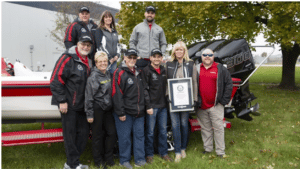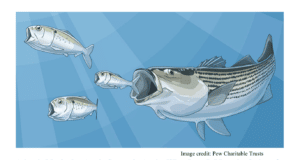As any barefoot enthusiast will tell you, skis are overrated. Why rely on fiberglass or wood planks when you can get the job done on your own two feet? Think barefooting is outside your comfort zone? Prepare to be surprised. We were taught by the pros at Florida’s Ron Scarpa Watersports (800/292-3668 www.ronscarpa.com). This simple method makes ‘footing accessible to almost any skiing enthusiast. All it takes is a wakeboard, a boat, and a relatively modest boat speed. Learn it, and who knows…you may become another ‘footin fanatic.
Assume the Position
A barefooter’s stance keeps his center of gravity low and helps prevent fatigue. Keep your eyes focused on the horizon, shoulders rolled back, arms straight and relaxed. You should look as if you’re sitting in a chair. Place your hips slightly in front of your shoulders. Keep your knees bent, knees in front of hips, and feet slightly in front of knees.
Need for Speed
With little surface area on the water, barefooters rely on speed to keep them moving. Still, ‘footers must learn to tame the speeds that can lead to injury. Most adults should be able to barefoot at around 35 mph.
Get the Goods
Experienced barefooters need little gear to slide across the water, but a newbie is another story. First, grab a wakeboard and remove the bindings. This will be your platform. A good, nonstretch towrope is also necessary. Finally, protect your body with a full-length, john-style wetsuit and a well-fitted PFD.
1. Jump in the water with your wakeboard and straddle it, much like you would sit atop a surfboard. Your balance should be centered slightly behind the middle of the board, with your ankles tightly gripping the sides, toes tucked just underneath the edge. It’s a balancing act; if you feel tippy, lie back on the board to make it easier to balance. Hold the tow handle at waist level, and when ready, signal the towboat to slowly accelerate.
2. As the boat begins to pull you forward, lean back slightly to keep the tip of the board above the water. Once you’re comfortable skimming atop the surface, sit up and begin to slide your bottom forward on the board. This is best accomplished by setting your feet on the nose of the board and “bumping” your butt forward. Have the boat accelerate to about 10 mph.
3. At this point, you should be stable riding atop the board. Relax your arms, and move your feet off the wakeboard so they rest on the surface of the water. Keep the vast majority of the weight centered over your butt on the board. Your feet should simply be skimming across the water. When you’re ready, give a nod to your observer to have the driver accelerate to 35 mph.
4. As the speed increases, allow your feet to slide toward your rear, so you are now supporting more of your weight on your feet. Don’t try to stand; you should begin to rise off the board automatically as speeds increase and you transfer more weight to your feet. Once up, keep toes slightly elevated, knees bent, and shoulders back. At the end of your ride, simply let go of the rope and sit back on your rear end.









